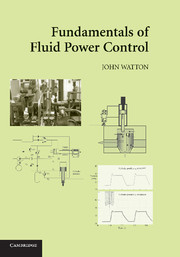6 - Control Systems
Published online by Cambridge University Press: 05 June 2012
Summary
Introduction to Basic Concepts, the Hydromechanical Actuator
The interconnection of components to form a closed-loop control system introduces new features, primarily the consideration of steady-state error and the speed of control. Steady-state error is a function of component design, such as the existence of a servovalve spool underlap, and the speed of control is a function of the way control is dynamically achieved combined with the dynamic characteristics of the system. It has been shown in Chapter 5 that fluid compressibility and load mass–inertia play the dominant part when characterizing system dynamics, and these aspects cannot be neglected when the dynamic stability of a closed-loop system is considered. Increasing system gain – for example, by increasing a servovalve servoamplifier current gain in a closed-loop servovalve–actuator position controller – will eventually lead to closed-loop instability. This will result in severe oscillations that could rapidly lead to component damage.
The hydromechanical actuator is one of the simplest forms of closed-loop control with applications reaching back to the very earliest days of industrial manufacturing using cast-iron components and low-pressure water as the working fluid. It incorporates a spool valve and an actuator – for example as shown in Fig. 6.1.
It will be seen that as the handle is moved to the right, the spool valve opens, allowing pressurized fluid to move the actuator in the same direction as the handle movement. In its basic form, it therefore acts in a manner similar to that of a servovalve–actuator system.
- Type
- Chapter
- Information
- Fundamentals of Fluid Power Control , pp. 323 - 420Publisher: Cambridge University PressPrint publication year: 2009



